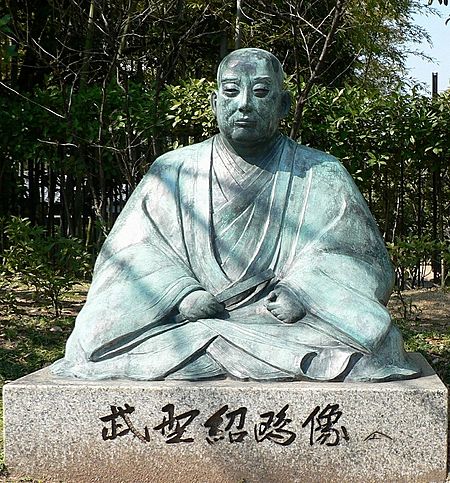Takeno Jōō facts for kids
Takeno Jōō (武野 紹鴎, 1502–1555) was a very important person in the history of the Japanese tea ceremony. He was also a well-known merchant (a person who buys and sells goods) during the Sengoku period (a time of war and change) in 16th-century Japan. He is famous because he helped develop a simple, quiet style of tea ceremony called wabi-cha. He also taught the famous tea master Sen no Rikyū.
Early Life and Family
Takeno Jōō's family might have come from the Takeda clan, who were protectors of Wakasa Province. His father, Nobuhisa, changed the family name to Takeno. Nobuhisa traveled around Japan before settling in Sakai, a busy port city. There, he built a successful business selling leather goods, which were often used by warriors. Jōō's mother was the daughter of a priest from the Kōfukuji temple in Yamato Province (which is now Nara Prefecture).
While helping with his family's business in Sakai, Jōō had another important role. His common name was Shingorō. He worked as an attendant at the Hongan-ji temple in Yamashina, Yamashiro Province (now part of Kyoto). In 1532, he became a monk and was then known as Jōō.
A Love for Poetry
For a long time, until he was about 35 years old, Jōō wanted to be a teacher of renga. Renga was a type of group poetry where people would link verses together. He also loved waka, which is a traditional Japanese poem.
In Kyoto, he learned the secrets of waka from a noble master named Sanjōnishi Sanetaka. Because Jōō was very wealthy, he was able to collect many old and important books about waka poetry.
Developing the Tea Ceremony
Around this time, the tea ceremony, called chanoyu, became very popular in Kyoto. Jōō became interested in creating a style of chanoyu that fit the customs of the people in Sakai, rather than just following the Kyoto style.
His poetry friends, like Sanjōnishi, and his Zen training (a type of Buddhist meditation) greatly influenced how he developed his tea ceremony style. He focused on simplicity and naturalness.
Famous Students
Jōō had two very important students in Sakai. One was the rich merchant Imai Sōkyū, who later married Jōō's daughter. The other was Sen no Rikyū, who would become one of the most famous tea masters in Japanese history.
Eventually, Takeno Jōō became known as the most important tea master in Sakai.
Legacy
Takeno Jōō passed away in 1555. His son, Takeno Shingorō (also known as Takeno Sōga, 1550–1614), was only six years old at the time. Shingorō inherited his father's large estate. As he grew up, he also became known as a tea master, following in his father's footsteps. Imai Sōkyū, Jōō's son-in-law, helped take care of Shingorō as his guardian.


